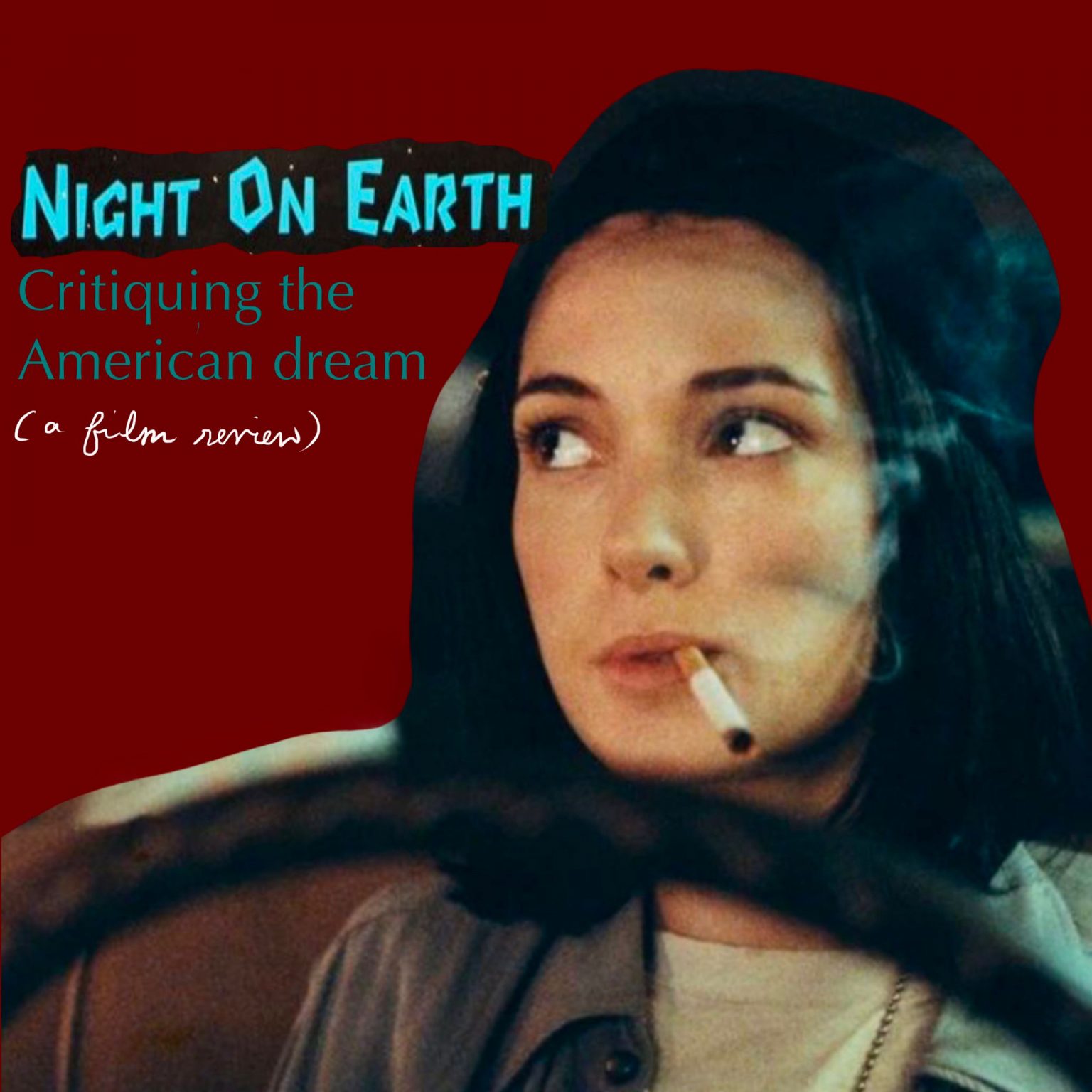Written by: Callum McGrath
An unhurried and leisurely independent film, Jim Jarmusch’s ‘Night on Earth’ reveals some peculiar and candid conversations had in five taxi journeys across the globe in one night.
Director: Jim Jarmusch. Starring: Winona Ryder, Gena Rowlands, Giancarlo Esposito, Roberto Benigni, Armin Mueller-Stahl. R cert, 129 mins.
In his five-vignette independent film, Jim Jarmusch’s Night on Earth takes viewers on a different taxi journey across each of five cities – Los Angeles, New York, Paris, Rome and Helsinki – in one night. Filmed with velveteen richness as dusk bleeds into night, each city features a distinct and thought-provoking passenger-driver interaction; some are funny, others are tragic, but all are unified in that the characters find a shared sense of compassion. Jarmusch’s arthouse films are characterised by character-driven, slow-paced narratives, often featuring deadpan, humorous conversations. As with other of Jarmusch’s films, Night on Earth features multiple languages, offering viewers a heterogenous import of cosmopolitanism. The film was fairly well-regarded by critics at the time, though received no major award nominations. In the more than thirty years since its release, it has arguably been ‘swept under the rug’, receiving less attention that it deserves.
Jarmusch’s departure from mainstream Hollywood
During his interview with Peter Keogh, Jim Jarmusch was told: ‘It seems that each of your films move further out of town. First to more distant American cities, and now international.’i If ‘town’ refers to Hollywood’s mainstream, then ‘Night on Earth’ perhaps best exemplifies this departure. But in a modern era that shows no signs of slowing down, it is the film’s critique of the American Dream and hyper-modernity that makes it a worthwhile watch.
‘You’re really happy driving this taxi? Is that your whole goal in life?’ So asks Victoria, a Hollywood casting agent, who has just offered her charismatic cab driver an acting role. Corky, the driver, declines: ‘I want to be a mechanic’, before dropping her customer off in Beverley Hills and driving away to her next pickup. Corky’s departure from this Hollywood neighbourhood in the film’s first vignette does not just signify her decline of the offer – it mirrors Jarmusch’s own directorial career. As an independent filmmaker, Jarmusch’s cinema does not conform to mainstream Hollywood conventions. His unhurried film style relies on static camera movement and infrequent cuts – the antitheses of cut-heavy kinetic cinematography of mainstream narratives. His films have a penchant for exploring the lives of peculiar and unusual characters, a prime example of which is Corky.
Victoria’s Beverly Hills residence is more than just a taxi destination – it is the nucleus of stardom and wealth, the pinnacle of the American Dream. But for Corky it is only a temporary stop, as she postulates a different version of that dream – one of blue-collar car work. Corky’s nonchalance to a highly sought after Hollywood career offer challenges traditional thought around the importance of money and status. Using the film medium to convey this almost disparaging view of the industry is an audacious decision by Jarmusch; perhaps a daring critique of materialism within the industry itself of which he is a reluctant part, and of which his career has sought to break away.
With each chapter featuring a different pair of cast members, there is some difficulty for the viewer to develop an extended affinity with a particular character. A stand-out performance, however, is that of Winona Ryder. Her embodiment of Corky’s humorous, relaxed persona – brought to life through acts such as chain smoking, endless chewing of gum and the wearing of a backwards baseball cap – makes the opening chapter’s taxi driver rebelliously loveable. This memorable performance pairs well with that of Hollywood veteran Gena Rowlands, who plays Corky’s passenger (Victoria). Despite the vast difference in age and social status of Corky and Victoria, the former builds rapport between the pair, an outcome largely down to Ryder’s witty and captivating performance.
The aesthetics and setting of Night on Earth
Perhaps what I enjoyed the most about Night on Earth is that it depicts the intimate connections made by cab drivers and passengers across the globe, even in the briefest of nighttime encounters. These conversations are coupled with Jarmusch’s long takes and infrequent cuts, enabling viewers to leisurely appreciate the urban setting. The film’s colour palette creates vividly candescent images of the nocturnal cityscape in a fashion that has been likened to Edward Hopper’s paintings.ii Radiant hues of crimson and amber become increasingly present as night sets in, with these vibrant colours reflected on the taxi’s bonnet for much of the ride. A great deal of the film’s drive through each of the cities is surprisingly featureless. We see extended shots of seemingly bland, desolate spaces of urban modernity, an anti-aesthetic to the galvanising, sleepless cities of twenty-four-hour action often depicted in more conventional films.iii
Jarmusch and ‘the undramatic everyday’
Upon further reflection, the settings are far from dull. In relation to ‘slow cinema’, Andrew Klevan discusses ‘the undramatic everyday’ – the seemingly bland, ordinary elements of quotidian life that tend not to gather much attention in mainstream film narratives. Klevan draws on the philosopher Stanley Cavell’s argument that history should take interest in ‘the uneventful’, and seek ‘what is not out of the ordinary.’iv Night on Earth that takes an interest in these concepts. We see shots of empty petrol stations, dimly-lit spacious roads, or vacant car parks. These bland areas epitomise ‘the undramatic everyday’ by seemingly adding nothing to the plot, but everything to the viewer’s precious time. Instead of featuring action-packed storylines, each of the chapters feature slow camerawork and melodic, leisurely dialogue.v There are extended periods of stagnancy and inactivity, and what can, at times, feel like a lack of narrative progression.
But it is these moments that makes the film special. Klevan asks whether it is possible to discover: ‘what is fascinating in the ordinary without romanticising it, without transforming it into […] something dramatic.’vi It seems that Night on Earth has our answer. Through Jarmusch’s presentation of these undramatic spaces, it is possible to find fascination in the ordinary. Corky’s preference to work in these unglamorous, everyday spaces instead of Hollywood makes her rejection of the job more powerful; it shows that to some, there is something of value in the ordinary. For perhaps the first time in motion picture history, ordinary is interesting. It adds value. In this way, Corky’s rejection of the job mirrors the film’s slow aesthetic – just as she declines the desirable life of an actress, Jarmusch declines the fast-paced cinematic conventions of mainstream Hollywood, and opts to make a slow film.
Is it worth a watch?
Some elements of Night on Earth, especially its unhurried filming style, may not appeal to fans of mainstream cinema. However, audiences should not overlook the fact that it is an anthology of peculiar, heartfelt stories. Despite the title’s astronomical connotations, Night on Earth revels in small details. The narrative is unique in that it is comprised exclusively of taxi journeys – a seemingly unimportant storyline feature that ends up in the editing room bin of most mainstream films. But Jarmusch turns trash into treasure, and brings the viewer on a rather pleasant ride – a ride that any film fan should take.


